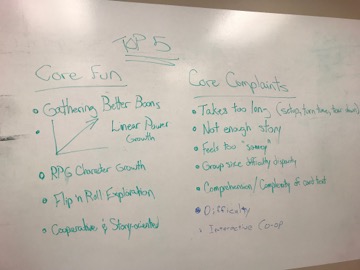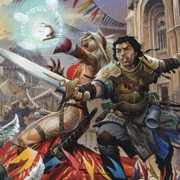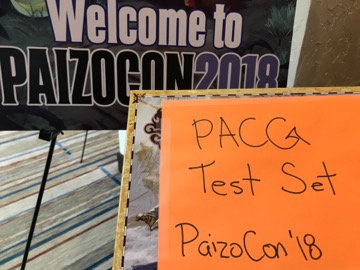Core Principles: Designing the Next Pathfinder ACG
Thursday, June 7, 2018
Last Friday, our team turned over to project lead Vic Wertz the first draft of the upcoming Pathfinder Adventure Card Game Core Set. This is a new type of box set, about which I'll go into detail below and in later articles in this series, which will run for the next year. Sometimes I'll write it, and sometimes you'll see the musings of the other members of our highly talented design team.
It is not coincidental that this turnover came at the end of a highly eventful week for the Pathfinder ACG design team. As we began shipping our upcoming games The Ninth World and Thornwatch, the Lone Shark designers took the so-called "final" version (SPOILER: it wasn't) of the Core Set to PaizoCon, our favorite convention to run PACG at. At Saturday night's Preview Banquet, I revealed the not-at-all-surprising fact that we were making a new Core Set, as well the slightly bigger surprise that the next Adventure Path is based on the beloved Curse of the Crimson Throne.
The Core Set can be played by itself, if that's all you want—its story content is based on the Pathfinder Module The Dragon's Demand—and we're increasing the replayability even over previous sets. But when you combine it with Curse, you'll have something about the same size as previous Adventure Paths. Importantly, you need Core for Curse, because the latter needs the former as a foundation to function. That's true for every adventure we want to make going forward. So when we produce another Adventure Path, or even perhaps a smaller adventure, you'll combine it with the Core Set and get an experience similar to Rise of the Runelords or Mummy's Mask. I described at the banquet how Core was basically done in design, and Curse was well underway.
I described how both would release just before PaizoCon 2019, which made a lot of people there very happy. Me, for example.
And then I went into why we were making it now, and really what we were and weren't making. Some of it supplemented this blog, but since it's a year later, I actually knew what I was talking about this time. So now I'll tell you.

I would like to officially note that we are fully capable of making a Top 5 list that stops at five.This graphic has been on our design team's whiteboard for several months. Its goal is to remind us what we're doing and why.
What's Staying the Same
The most important element of this project is perhaps the least obvious: We want to keep making the game we've been making. Throughout my career, I've helped lead many reboots and expansions—D&D 3rd Edition, Axis & Allies, Attack!, and Betrayal at House on the Hill, to name a few. Each time I've started by spelling out how much we wanted to move the goalposts. That has typically defined whether we're making a new set or a new edition.
As I've said for a while, we're not making this a "second edition." Our goal isn't to invalidate anything you have currently; everything you own for PACG is still good and will continue to be. What we are creating now will interlock nicely with Skull & Shackles, Wrath of the Righteous, Class Decks, and everything else that has come before. Some things are changing around the edges, including some important terminology. but as we saw in our PaizoCon playtests, people got those changes within minutes and were off playing without hesitation.
At the heart, the PACG experience involves five cornerstone principles:
- Improving your character by acquiring better boons for your deck.
- Increasing your character's power along a linear arc, corresponding to an increase in the difficulty of challenges.
- Giving you a variety of ways to grow your character over time and make it your own.
- Letting you explore the world by encountering cards and dealing with their challenges.
- Doing so as a part of a cooperative team in an involving story.
None of this is going to change. We're not adding a PvP option, dynamiting your role cards, or flattening out the power curve. These cornerstone principles had to be observed when considering any change we wanted to make. Fortunately, a whole lot of changes still fit under that tent.
What's Changing
Over the last five years, we've heard a lot of the same complaints. (We've especially heard them from inside our office.) We figured we could use that experience to spruce up PACG to be a better, faster, smarter game. We looked hard at these challenges:
- The game is a bit too slow in all phases: how long it took to set up, how long it took to take a turn, how long it took to tear down. We looked for solutions that sped up everything, even if we gained just a few seconds here or there.
- For a game set in one of the most expansive fantasy worlds ever made, we gave you too little story. The opportunity we had to tell stories was mostly limited to tiny boxes on the backs of cards, and conveyed very little of the depth the orignal storytellers had given us.
- Though we tell many different stories, the game often gives off a feeling of sameness. We did morph from only having a few different scenario types in Rise of the Runelords to having only a few "standard" scenarios in Mummy's Mask. But more can be done.
- Groups of players get varying experiences by group size. A solo character is less likely to run out of time and more likely to die; the reverse is true for large groups. While that's fine, giving people the ability to toggle those variables seemed smart.
- Many cards have complicated text. We've piled template upon template, sometimes requiring three or four powers on a card before we started making it interesting. Certain card types like armors and spells got burdened in ways we never envisioned.
- Some sets were easy and some were hard, but regardless there was no way to control difficulty. If you wanted to make the game harder, you were on your own. We will benefit from giving players controls for this.
- For a cooperative card game, the game is often not interactive enough. When you want to help your friend, the game generally tells you that you can't unless you have a card that does so. It's a co-op game, so it should feel more cooperative.
In addition to a design team that has grown and learned from all our iterations of the game, we had three other resources to use to achieve some of these goals. None of them existed when we made Rise of the Runelords, but all had been successful in its wake. The first was the Pathfinder Society Adventure Card Guild, which showed us new ways to tell and organize stories. The second was Obsidian's Pathfinder Adventures app, which showed us ways to make the game sleeker and faster. The third was Lone Shark's second ACG, Apocrypha, in which we addressed a lot of these concerns.
In the next installment of this design diary, I'll talk about how we used those tools to address one of those big challenges: injecting more story. Thanks for reading!
Mike Selinker
Adventure Card Game Lead Designer
We have updated our Privacy Policy.
Paizo.com uses cookies. You can block paizo.com from using cookies within your browser settings, but doing so will hinder site functionality.
More information can be found in our Privacy Policy.



